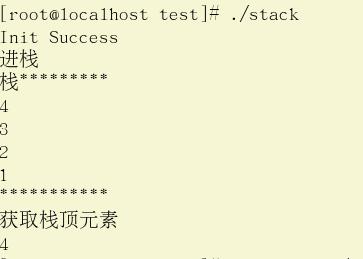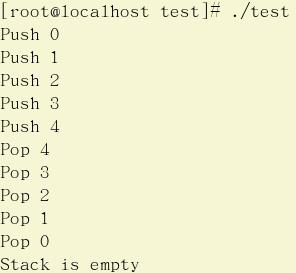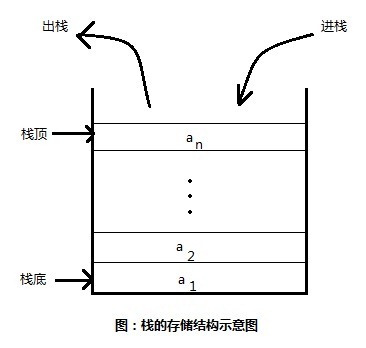原文地址:http://www.cnblogs.com/mcgrady/p/3213289.html
上一篇总结完了线性表之链表,这一篇文章我们要总结的是栈,我想从以下几个方面来进行总结。
1,什么是栈?
2,栈的存储结构?
3,栈的常见操作及代码实现?
1.什么是栈
首先栈是一种特殊的线性表。那它的特殊性表现在哪里呢?栈是限定在表的一端进行插入和删除运算的线性表,因此,栈也称为后进先出(LIFO)的线性表。
它有很多应用场景,比如食堂中的一叠盘子,我们只能从顶端一个一个地取。
2.栈的存储结构
3.栈的常见操作和代码实现
1,初始化
实现思路:用指定大小的length实例化一个SeqStack<T>,然后使top指针指向-1。
2,进栈
实现思路:将top指针加1,然后将新结点插入到top指针指向的位置。
3,出栈
实现思路:消灭top指向的结点,并使top指针减1。
4,获取栈顶元素
实现思路:与出栈相似,只是不改变栈的状态而已。
5,判断是否栈空
实现思路:如果top指针是否等于-1,如果是则返为空栈。
6,判断是否栈满
实现思路:检查top指针的值是否等于数组的长度,如果是则为栈满。
数组实现栈:
1 #include <stdio.h> 2 3 #define OK 0 4 #define ERROR -1 5 #define MAXSIZE 10 6 7 typedef int Status; 8 typedef int ElemType; 9 10 typedef struct 11 { 12 ElemType data[MAXSIZE]; 13 int top; //栈顶指针 14 }SeqStack; //顺序栈结构 15 16 Status Init(SeqStack *seqStack) 17 { 18 seqStack->top = -1; 19 return OK; 20 } 21 22 Status Push(SeqStack *seqStack,ElemType e) 23 { 24 if(IsFull(seqStack)) 25 return ERROR; 26 seqStack->data[++seqStack->top] = e; 27 return OK; 28 } 29 30 Status Pop(SeqStack *seqStack,ElemType *e) 31 { 32 if(IsEmpty(seqStack)) 33 return ERROR; 34 35 *e = seqStack->data[seqStack->top]; 36 seqStack->top--; 37 38 return OK; 39 } 40 41 Status GetTop(SeqStack *seqStack,ElemType *e) 42 { 43 if(IsEmpty(seqStack)) 44 return ERROR; 45 46 *e = seqStack->data[seqStack->top]; 47 } 48 49 int GetLength(SeqStack *seqStack) 50 { 51 return seqStack->top+1; 52 } 53 54 Status IsEmpty(SeqStack *seqStack) 55 { 56 return seqStack->top == -1; 57 } 58 59 Status IsFull(SeqStack *seqStack) 60 { 61 return seqStack->top == MAXSIZE -1; 62 } 63 64 DisPlay(SeqStack *seqStack) 65 { 66 int i; 67 printf("æ ˆ********* "); 68 for(i=seqStack->top;i>=0;i--) 69 printf("%d ",seqStack->data[i]); 70 printf("*********** "); 71 } 72 73 int main(void) 74 { 75 SeqStack seqStack; 76 int j; 77 ElemType e; 78 79 if(Init(&seqStack) == -1) 80 printf("Init Error"); 81 printf("Init Success "); 82 83 printf("è¿›æ ˆ "); 84 for(j=1;j<5;j++) 85 Push(&seqStack,j); 86 DisPlay(&seqStack); 87 88 printf("莕å–æ ˆé¡¶å…ƒç´ "); 89 GetTop(&seqStack,&e); 90 printf("%d ",e); 91 92 return 0; 93 }
运行结果

链表实现栈:
1 #include <stdio.h> 2 #include <stdlib.h> 3 4 #define OK 0 5 #define ERROR -1 6 7 typedef int Status; 8 typedef int ElemType; 9 typedef struct list 10 { 11 ElemType data; 12 struct list *next; 13 }List; 14 15 typedef struct stack 16 { 17 List* top; 18 }Stack; 19 20 void Init(Stack *stack) 21 { 22 stack->top = NULL; 23 } 24 25 void Push(Stack *stack,ElemType e) 26 { 27 printf("Push %d ",e); 28 List *p = (List*)malloc(sizeof(List)); 29 p->data = e; 30 p->next = stack->top; 31 stack->top = p; 32 } 33 34 Status Pop(Stack *stack) 35 { 36 List *p; 37 if(stack->top == NULL) 38 { 39 printf("Stack is empty "); 40 return ERROR; 41 } 42 p = stack->top; 43 printf("Pop %d ",p->data); 44 stack->top = stack->top->next; 45 free(p); 46 return OK; 47 } 48 49 int main(void) 50 { 51 int i=0; 52 Stack *s = (Stack*)malloc(sizeof(Stack)); 53 Init(s); 54 for(i=0;i<5;i++) 55 Push(s,i); 56 for(i=0;i<6;i++) 57 Pop(s); 58 59 return 0; 60 }
运行结果

